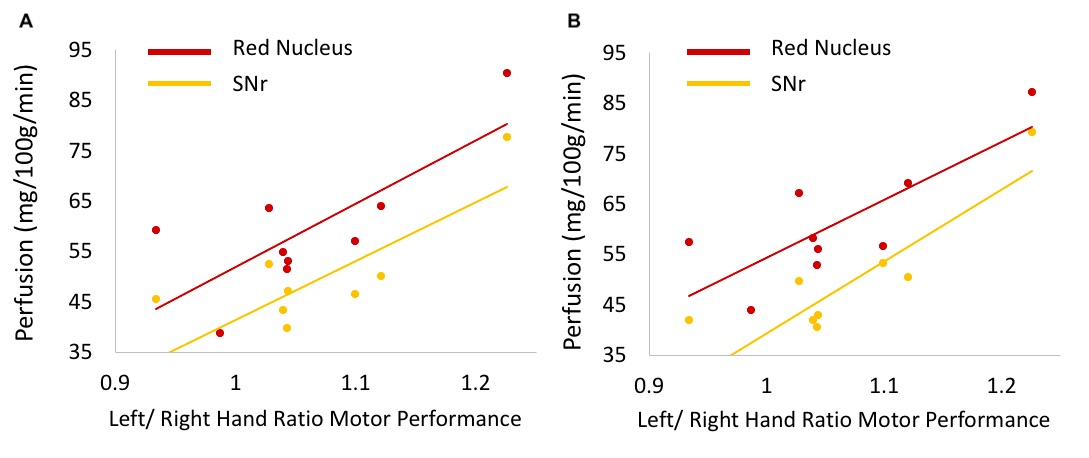Session Information
Session Type: Poster Session A
Session Time: 8:30AM-10:30AM
Background/Purpose: Juvenile Idiopathic Arthritis (JIA) is a common childhood illness, characterized by inflammation of the joint, chronic pain and decreased physical functioning. To date, the underlying neurobiological mechanisms that drive pain and sensorimotor dysfunction are unclear and understudied. Thus, in this pilot study, we explored the morphology and functionality of salience and sensorimotor structures in JIA patients.
Methods: Nine JIA patients (12.4 ± 2.8 years of age) and 13 control subjects matched by age, gender and handedness were enrolled. All JIA patients were on active treatment and had prior or ongoing symptoms in hand-wrist joints. High-resolution structural magnetic resonance imaging (MRI), diffusion tensor imaging (DTI), functional MRI (fMRI), and Pseudo-continuous arterial spin labelling (ASL) were performed. In addition, clinical lab tests and the 9-hole peg test for hand-motor function were administered.
Results: Morphology: Morphological analysis (Freesurfer v7.1.1) of the structural neuroimaging data revealed a significant decrease (P < 0.05) of cortical thickness in the left hemisphere insular cortex in JIA patients (Figure 1). Furthermore, cortical volume of the caudate nucleus (CN) was negatively correlated with patient-reported pain severity (Left CN: P = 0.04, R = -0.70; Right CN: P = 0.03, R = -0.71). Functional connectivity: In JIA patients, seed-based functional connectivity analysis (CONN-fMRI v18.b and SPM 12) showed altered connectivity from anterior insula (AI) subregions, as defined by Deen et al., to key hubs of the salience (e.g., anterior cingulate cortex (ACC)) and sensorimotor (e.g., pre- and postcentral gyri) networks. The most robust finding was that of decreased functional connectivity from the dorsal AI (dAI) to angular/ supramarginal gyrus regions in JIA patients (Figure 1). Structural connectivity: Probabilistic tractography (FMRIB’s Software Library v6.0.4) revealed higher connectivity from the left and right AI to several ipsilateral and contralateral regions of the salience network in JIA patients. Connectivity from the left ventral AI (vAI) to the left ACC, which is associated with affective processes, was increased in JIA patients (P = 0.015), and left vAI to right ACC was correlated to erythrocyte sedimentation rate (ESR) and pain (ESR: P = 0.03, Pain: P = 0.01) (Figure 1). Cerebral blood flow (CBF): CBF analysis (BASIL toolbox) did not reveal significant group differences for the insular cortex or other regions of the salience network (Figure 1). However, assessment of regional CBF in JIA patients and controls revealed significantly higher CBF values in multiple subcortical areas within the sensorimotor network for the JIA group (Figure 2). These values were positively correlated with left to right hand ratio motor performance, calculated from subjects’ time score on the 9-hole peg test (Figure 3).
Conclusion: This pilot study points toward several structural and functional alterations in salience and sensorimotor networks, which could be at the core of pain and sensorimotor deficits in JIA. Future studies may focus on whether central changes are maladaptive or adaptive in nature, and how CNS properties are impacted by standard of care and novel therapies.
To cite this abstract in AMA style:
van der Heijden H, Lemme J, Cay M, Sibai D, Goodlett B, Lo J, Nigrovic P, Chang M, Meidan E, Halyabar O, Hazen M, Taylor M, Hoyt K, Jaimes C, Henderson L, Ecklund K, Schreiber R, Sundel R, Upadhyay J. Structural and Functional Neurobiological Alterations of Salience and Sensorimotor Networks in Juvenile Idiopathic Arthritis [abstract]. Arthritis Rheumatol. 2021; 73 (suppl 9). https://acrabstracts.org/abstract/structural-and-functional-neurobiological-alterations-of-salience-and-sensorimotor-networks-in-juvenile-idiopathic-arthritis/. Accessed .« Back to ACR Convergence 2021
ACR Meeting Abstracts - https://acrabstracts.org/abstract/structural-and-functional-neurobiological-alterations-of-salience-and-sensorimotor-networks-in-juvenile-idiopathic-arthritis/



